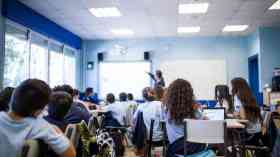Pupils, pencils and pathogenic bacteria
 The close contact nature of the classroom and children’s often poor hygiene can result in bacterial infections quickly spreading from child to child. This is why school classrooms make the ideal environment for germs to thrive.
The close contact nature of the classroom and children’s often poor hygiene can result in bacterial infections quickly spreading from child to child. This is why school classrooms make the ideal environment for germs to thrive.
With the aim of creating a cleaner, safer classroom for young children, the world’s first antimicrobial classroom was created using products that actively reduce microbes. Each product was BioCote protected, including desks, chairs, bookshelves, carpet and paint. As the products contain BioCote, they benefit from permanent, continuous protection against a wide variety of microbes, including those that are potentially harmful to our health. Whilst all BioCote protected products are quality control checked during manufacture to ensure superior antimicrobial performance, how well do they perform in real life?
To answer this, BioCote tested a wide range of products in a school classroom to see how they fared. The results that followed confirmed that BioCote protection is as effective in real life as it is in the laboratory there was a huge 96 per cent reduction in bacterial levels in the total environment. This result was achieved by comparing the amount of bacteria on BioCote protected products and comparing them with bacterial levels on equivalent products from an unprotected classroom.
Following this result, the microbiologists wanted to understand not just how many bacteria, but the potential significance of what species were found lurking in the two classrooms.
Prediction
Before commencing the study, the obvious expectation was to find a variety of microbes associated with humans. It was expected this would include both commensals (not harmful) and pathogenic (disease-causing) strains. This is because of the numbers of pupils in a classroom, the close and prolonged nature of their interaction, an almost constant supply of new microbes each school day, isolated cleaning practices and the knowledge that bacteria can survive and thrive on surfaces for many hours or even days.
Microbes found in the classroom
The results were conducive to the microbiologists’ prediction. Many of the bacteria collected from the school room samples were identified as microorganisms of human origin and could be considered typical of those recovered from products and surfaces within environments people occupy. Back in the laboratory various techniques were employed to identify the species of microbes recovered from the products in both classrooms, it was found these included those bacteria that we live alongside happily every day, but also various strains of pathogenic bacteria that could cause illness in both pupils and staff, which could of course lead to absenteeism.
Amongst these are the exotically named Staphylococcus aureus, Staphylococcus epidermidis, and Escherichia coli. Staphylococci bacteria are commonly associated with human skin, but are also associated with other sources. They are responsible for a wide variety of infections. Whilst hand washing can reduce their spread, worryingly, antibiotics are largely ineffective at treating them. The coliform bacteria including E.coli are known to contribute to the bacterial population of the human gut. Most E. coli strains are harmless, but some can cause serious and unpleasant food poisoning type symptoms.
The spread of microorganisms
The bacteria identified in the study were found on many of the surfaces in both classrooms, whilst there was no discernible picture of distribution of microorganisms in either school room, some objects were more contaminated than others. More telling, however, was the nature of those surfaces that harboured pathogenic bacteria. Over eighty per cent of pathogenic bacteria identified were found living on products within the unprotected school classroom. This indicates that not only did the BioCote protected products limit the existence of any bacteria in the protected classroom, it also actively reduces the presence of bacteria that could lead to illness amongst pupils and staff. This reinforces the argument for antimicrobial surfaces in school environments to reduce the number of pathogens that are likely to contaminate them and their unwanted impact on school attendance figures.
This, and previous related studies, show how products protected with antimicrobial technology can sustainably be incorporated into human-centric environments with a proven beneficial effect on hygiene. Reducing the overall levels of microbial contamination by the use of products protected with BioCote technology has been repeatedly demonstrated by these types of studies, as well as the increasing evidence that points to the reduction of bacteria capable of causing human disease thanks to antimicrobial technology. It can be safely assumed that fewer pathogens in an environment used by people will result in the reduced potential of human infections. As the science of antimicrobial technology continues to advance, we should raise our sights to understanding the ability of antimicrobial technology reducing school absenteeism due to illness because the culprit microbes are continuously being eliminated from the surfaces of the products, and in this case, the school classroom.
Further information
www.biocote.com
Latest News
14/11/2025 - 11:04
England’s councils are warning of a "ticking time bomb" in the special educational needs and disabilities (SEND) system, with new data showing deficits that could bankrupt local authorities within three years.
13/11/2025 - 12:14
Event for school leaders, governors and education professionals relocates to the historic Old Billingsgate venue in London.
13/11/2025 - 09:49
The regulations have been set following a second consultation and detailed collaborative working with organisations and people across deaf and hearing communities.
13/11/2025 - 09:39
The Education Committee has published a letter to the Secretary of State for Education asking for more detail about the Department for Education’s work on developing its SEND reforms.
13/11/2025 - 09:26
New analysis by NFER has highlighted the uneven distribution of pupils with special educational needs and disabilities (SEND) across mainstream schools in England.







